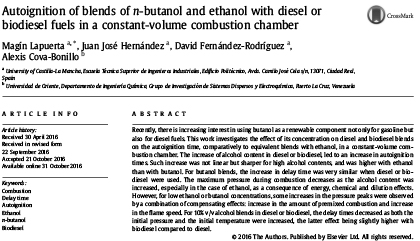The following conclusions can be drawn from the present study: The increase in alcohol content in diesel or biodiesel fuels always led to an increase in both IDCF and IDM. Such an increase was sharper at high alcohol contents. This implies that weight or volume averaging of autoignition parameters (such as cetane number) is not an accurate method to predict the autoignition behaviour of alcohol blends. The increase in the delay time with the ethanol content is more prominent than for butanol. consistently with its lower cetane number. However. the differences in autoignition time become more visible when these alcohols are blended with diesel fuel whereas they become less significant when they are blended with biodiesel fuel (at least for high alcohol contents). For butanol blends. the increase in autoignition delay time is very similar when diesel or biodiesel (with similar cetane numbers) were used in the blends. However. some differences appear when ethanol is blended with diesel or biodiesel fuels. with larger delay times in the former case.

 Iran Energy News Oil, Gas, Petrochemical and Energy Field Specialized Channel
Iran Energy News Oil, Gas, Petrochemical and Energy Field Specialized Channel



